This blog can be translated into multiple languages. Please scroll down for Google translate tool.
Purandar and Vajragad are twin forts near Narayanpur less than 50 km from Pune. It is the birthplace of Chhatrapati Sambhaji Maharaj (r. 1657 to 1689 CE), Shivaji's eldest son.
The sequence of events leading to the fort of Purandar are prior to that of the Coronation ceremony of Chhatrapati Shivaji Maharaj at Raigad. Refer to the previous blog post by clicking on the link.
Exploring Purandar fort
Similar to all Shivaji forts, Purandar evokes a deep sense of Hindutva and Nationalist pride among Indians. People from all walks of life come here~ families, trekking groups, school/ college educational trips etc.
Getting here
Incase you plan on reaching here by public transport:
Pune (Katraj) to Saswad, via Dive Ghat: Rs. 30 by S.T. bus
From Saswad take a right to Naranpur: Rs 20 (share auto )
From Naranpur to fort mid-base parking lot: I paid Rs 200 (auto)
Fort entry protocol
The fort has an Army training area inside hence there are restrictions in place. Visitors need to get permission from the Army camp once you get there. ID proof (Aadhar card) is compulsory. Foreign nationals need to carry their passport.
Trekking trail to the peak of Purandar fort
Grade :- Easy, 4,472 Ft
Time for trekking : 1 Hour from mid parking
Open_ all days of the week
Time restrictions: 9 AM_ 5 PM
Things to carry: 2 litres water, some snacks
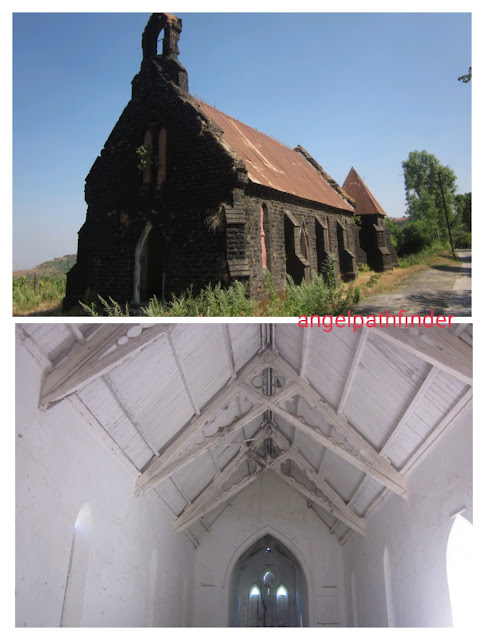 |
| An old ruined church from the British colonial days, Purandar fort |
The weather was just perfect, a bit sunny but tolerable. This would be my first attempt at a rugged trek without any assistance! Moreover, the sight of military personnel every now and then added to my anxiety. Then I spotted a quaint church from the British colonial days right near the 1st entry point.
1st entry point- Binni darwaza
The tar road goes past the 1st entry point, for 500 meters until one reaches the Shiva temple.
Brief History: Mughal-Maratha conflicts
Purandar existed since the 11th CE YADAVA Dynasty period and later passed through the hands of several Deccan Sultanates. Maloji Bhonsale, Shivaji Maharaj's grandfather who had been serving the Ahmednagar Sultanate received the fort as a grant in 1596 CE along with Pune and Supe. Shahji Bhosale (Shivaji's father) who inherited the fort kept shifting his loyalties from Ahmednagar to Bijapur to Mughals and back and so forth. As a result the fort passed on to the Adil Shahis of Bijapur.
In 1646 CE, Shivaji, then a teenager, started resisting the Bijapur Sultanate with the capture of Torna. The newly formed Maratha group seized Purandar shortly thereafter.
Mughals lay siege on Purandar
Until 1657, Shivaji managed to consolidate his gains from Bijapur Adil Shahis, while at the same time keeping the Mughals at arms length through diplomatic means. However, it seemed like a case of complete misplaced trust; for the Bijapuris it seemed, made the Mughals a more tempting offer. This enraged the Maratha!
In 1657, Shivaji began raiding Mughal interests in the Deccan causing heavy losses to the Mughals under emperor Aurangzeb.
In 1660, the Mughals retaliated by occupying Maratha territory of Pune, not sparing even Shivaji's personal residence Lal Mahal.
In 1663, Shivaji avenged this impudence by killing, wounding or taking captive most of Mughal commander Shaista Khan's household in a surprise nightly attack. Shaista, badly injured himself, was forced to flee. In order to replenish their losses, the Marathas continued raids on Mughal and European trading posts in Surat.
Aurangzeb found newer strategies to counter the Maratha warrior king. He appointed Jai Singh I (b. 1611, d. 1667) a senior Hindu Rajput general of the Mughal Empire for his campaign. Jai Singh was a shrewd commander who managed to lure Shivaji's key commanders and cavalrymen on his side and with whose help he succeeded in countering Maratha guerrilla tactics. Jai Singh-I's 15,000 strong force besieged many Maratha forts forcing Shivaji to retreat to Purandar fort. On 11 June 1665, the Mughal army also laid siege on Purandar thus weakening the Maratha position considerably.
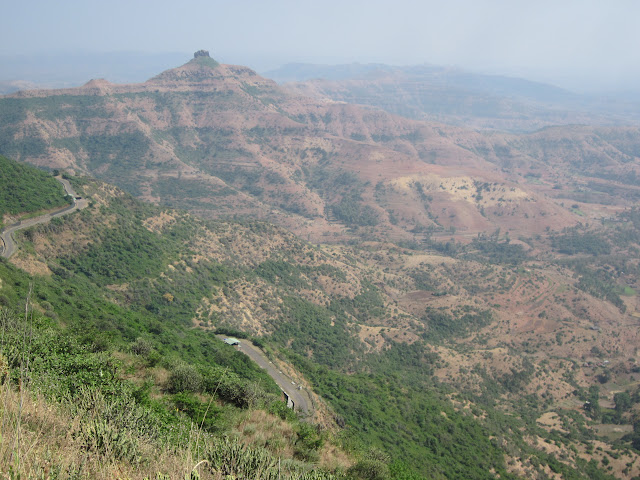 |
| The intimidating Sahyadris- Purandar, Maharashtra |
The legend of Murarbhaji Deshpande
Murarbhaji Deshpande was the killedar (keeper of the fort).
This statue of Murarbaji Deshpande, killedar of Purandar is slightly ahead of Binni darwaza. He laid down his life while fighting Mughals defending this fort.
The siege of Purandar lasted months. The Marathas would have easily held back the Mughals; had they (Mughals) not received the advanced cannons from the British. Despite heavy bombardment to the fortifications, Murarbhaji Deshpande and his 700 strong Maratha troop fought to the last man to defend the fort. Murarbhaji himself killed 100s of Mughal soldiers due to his excellent swordsmanship.
The Treaty of Purandar (11 June 1665)
The Marathas may have lost the battle that day, but their fierce courage will always be remembered. Shivaji was forced to sign The Treaty of Purandar that granted 23 Maratha forts to Jai Singh, plus 400,000 huns (gold coins) as compensation. Even worse, this defeat made the proud Maratha a vassal of the Mughal empire.
In 1670, Shivaji resumed his hostilities with the Mughals during which Purandar was recaptured by the Marathas.
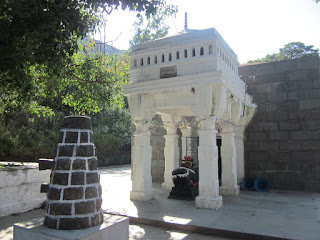 |
| Temple of Purandeshwar at Purandar fort |
Purandeshwar temple- This is a simple temple of Purandeshwar (Lord Shiva) the patron God of the fort.
A bit further from the temple was an army canteen. I stopped here for some refreshments/ tea break. This is the base of the steps and start point of the uphill climb. Ahead to the right is a statue of Chhatrapati Sambhaji Maharaj. Road to the left from here leads to Vajragad which is now closed.
The steep climb upward was tiring but adventurous. Every now and then I met people and we stopped by to say hello, but they seemed to be in a group. The steep climb continued until there came a bastion where a military personnel was keeping watch. After walking ahead, I spotted a few structures from that period. Oh how I longed to explore the place, but realised it's not worth taking the risk as a solo trekker.
💡If you are fit, the upward climb at a moderate pace should take 40-45 mins.
However, that was not the case with me. I was huffing and puffing at a terribly slow pace, taking frequent breaks to breathe in the fresh air and admire the surrounding Sahyadri landscape.
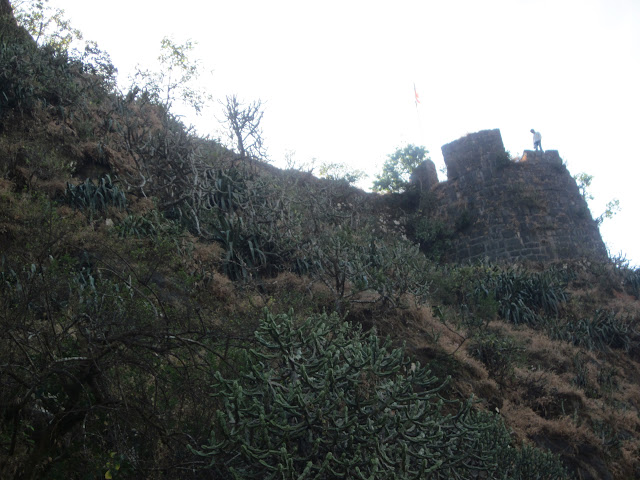 |
| Another rugged bastion at Purandar fort |
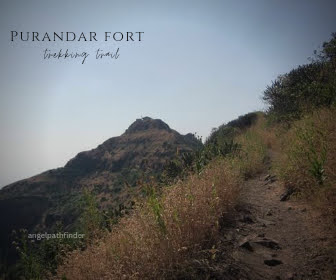 |
| Trail leading to Ballekilla, Purandar fort |
I had walked a long way up until a rock-cut water cistern. Beyond it were steps that would lead to the Balekilla ie. the topmost part of the fort.
But between me and those steps was a patch of scry dry earth at an incline of maybe 70°, that looked rather scary, or if I may say RISKY. An accidental slip would mean tumbling down in the valley below. And if it hadn't been for my fear of heights, there'd be no harm in getting past it with care and ease.
I waited patiently for someone to pass by... I finally spotted a few lads coming from the opposite way! ...They caught my hand, balanced my weight and got me past.
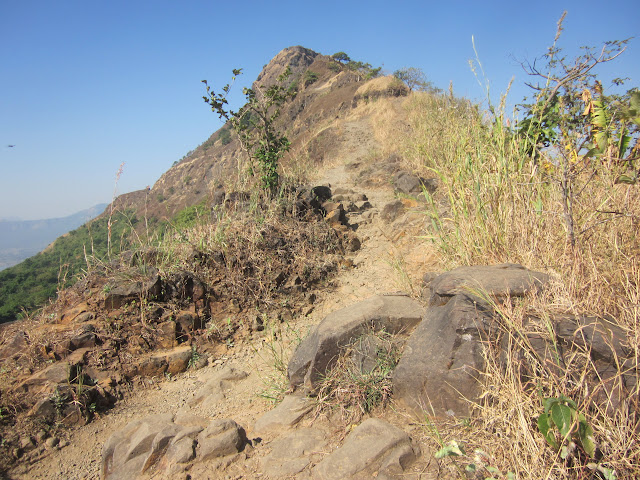 |
| The tricky patch along the trail leading to Ballekilla, Purandar fort |
'Oh my God!' I wondered 🤔 what shall I do on my way back?!
Climbing up these remarkable rock-cut steps that are chiselled across the ridge, leading up to the Ballekilla, sets you back in time. The feeling of being in a completely different dimension altogether.
💡On a foggy day, this part of the fort is covered in mist and over-hanging clouds. Even the trail can be slippery.
And here I was!! At the highest point of Purandar - Kedareshwar mandir (another Shiva temple). From this point one can get a 360° panoramic view of the Sahyadris. On a clear day ~ Saswad town below, Sinhagad, Rajgad forts and Veer dam can be seen from here.
![Kedareshwar mandir, the highest point of Purandar fort [Shivaji forts, Maharashtra] Kedareshwar mandir, the highest point of Purandar fort [Shivaji forts, Maharashtra]](https://blogger.googleusercontent.com/img/b/R29vZ2xl/AVvXsEjaMgU0LOk09ae3wzdltKeyV0rF2HoZRMDXKa96burbcADP8CA5SBW7IZEfwl-Yy45fw7xHg-ZVohjrBDToswjxJe_uG-OEW6E0WSBqEa9yq571f9PiLWWqRhSXGjtGaPLqVTx5LjiPSydzzBUfjMtb9EzglJeDRRsUzYOD2PyC27PnB46ltYs9voKE/w480-h640/12a19-%20Purandar%20solo%20effort.JPG) |
| Kedareshwar mandir, the highest point of Purandar fort [Shivaji forts, Maharashtra] |
TASK ACCOMPLISHED!
THE DESCENT
It was 5 pm! The tricky patch seemed trickier during descent plus there wasn't a soul in sight. Not willing to wait any longer I sat down flat and began scraping along on my butt as quickly as possible till I got to the other side.
Once that was done- I was elated beyond words! The evening glow threw pretty lights here and there. The mountains looked mysterious and yet so beautiful. I reached the fort base and onward the parking lot by 5.35 pm. Luckily, I even got a ride to Saswad village down below.
A bit about SASWAD
Saswad is a village at the foothills of Purandar. It falls along the annual Alandi-Pandharpur route. Saswad is also home to Balaji Vishwanath Bhat (in office from 1713-1720 CE). He was the 1st Peshwa (prime minister] of the Maratha empire under the reign of Shahu I (grandson of Shivaji Maharaj).
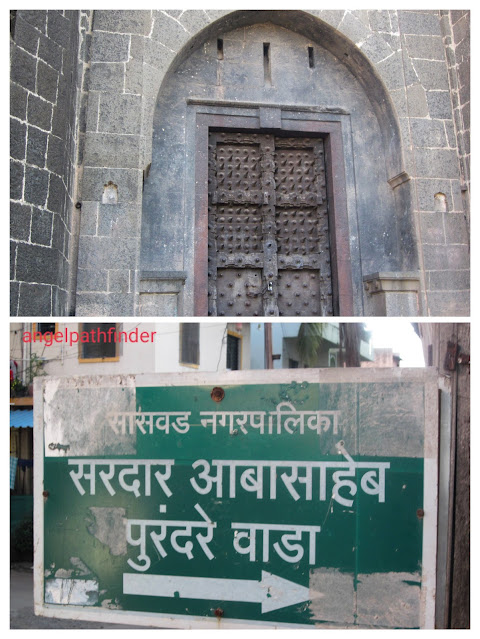 |
| The impressive looking entrance of Sardar Abbasaheb Purandare wada, Saswad Pune |
Walking along the lanes of Saswad I saw this impressive looking wada in utter ruins and disrepair. Sadly no one could provide any valuable info, the best they could do was prohibiting me from getting too close. "There may be snakes in the rubble," they warned me... And they could be right.
Saswad also has a few temples of antiquity from the Marathas (Peshwa era). I would surely love to stay back and explore more, but it's almost 6.30 pm and I'm tired.
Hope you enjoyed reading this blog post. Do put in a comment and let me know what you think and share it with others.🙏
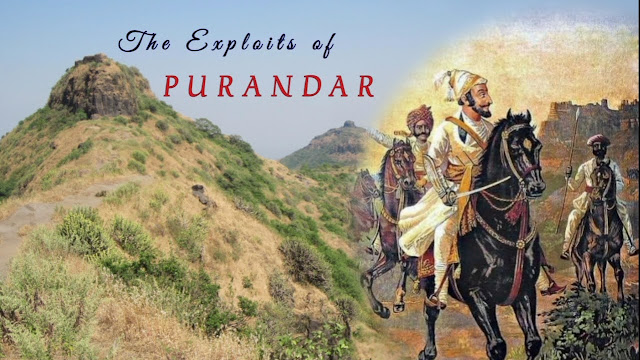

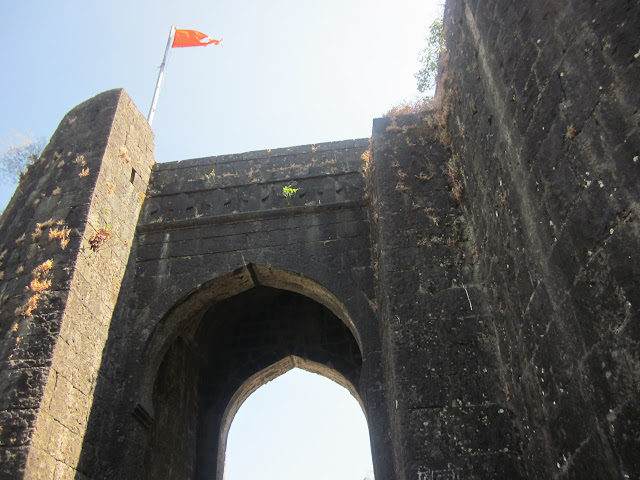

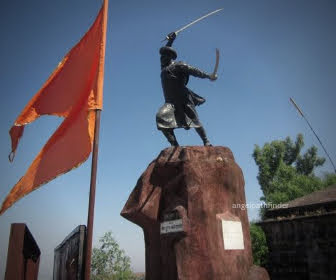




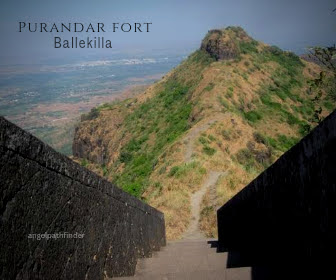
![Kedareshwar mandir, the highest point of Purandar fort [Shivaji forts, Maharashtra] Kedareshwar mandir, the highest point of Purandar fort [Shivaji forts, Maharashtra]](https://blogger.googleusercontent.com/img/b/R29vZ2xl/AVvXsEjaMgU0LOk09ae3wzdltKeyV0rF2HoZRMDXKa96burbcADP8CA5SBW7IZEfwl-Yy45fw7xHg-ZVohjrBDToswjxJe_uG-OEW6E0WSBqEa9yq571f9PiLWWqRhSXGjtGaPLqVTx5LjiPSydzzBUfjMtb9EzglJeDRRsUzYOD2PyC27PnB46ltYs9voKE/w480-h640/12a19-%20Purandar%20solo%20effort.JPG)

Comments
Post a Comment